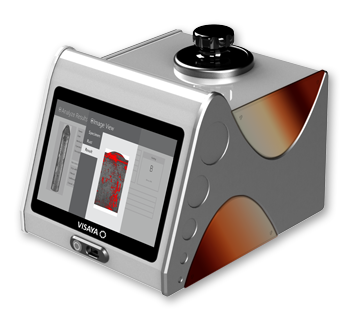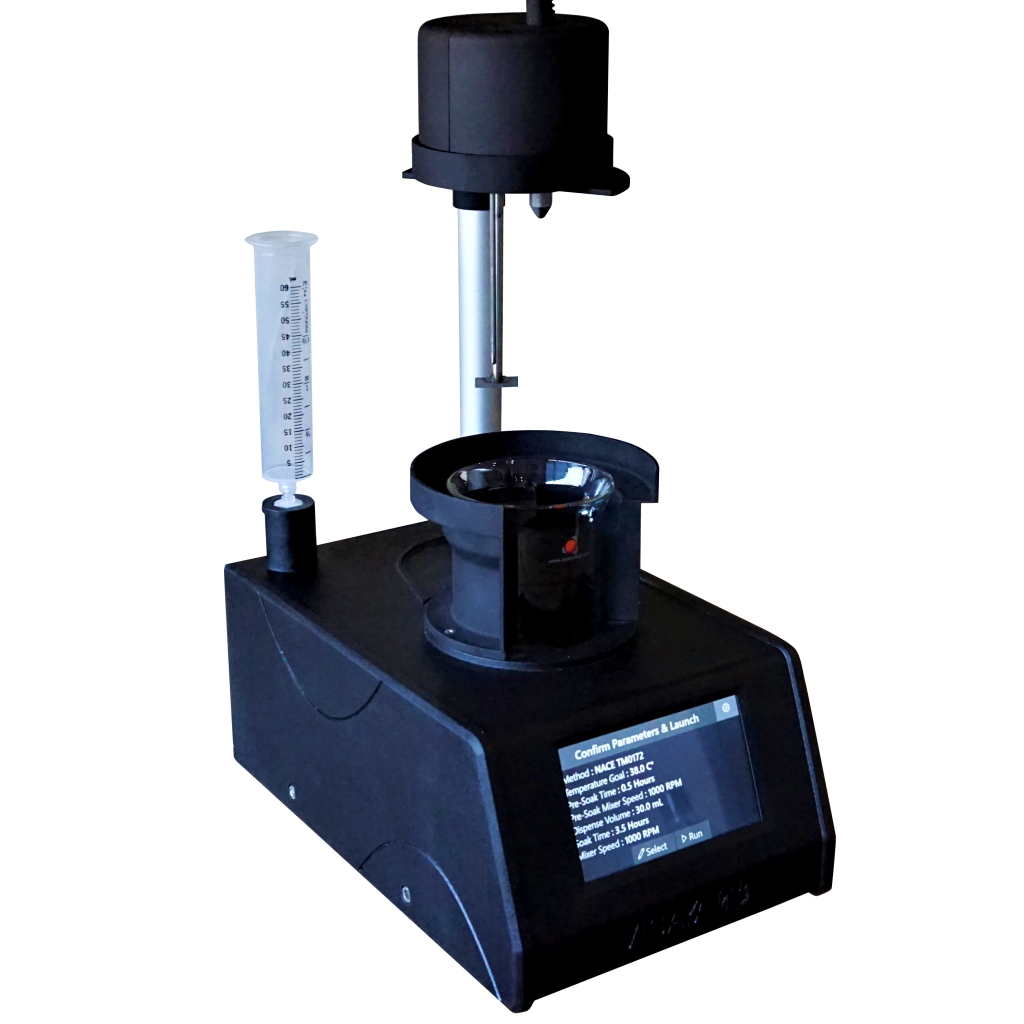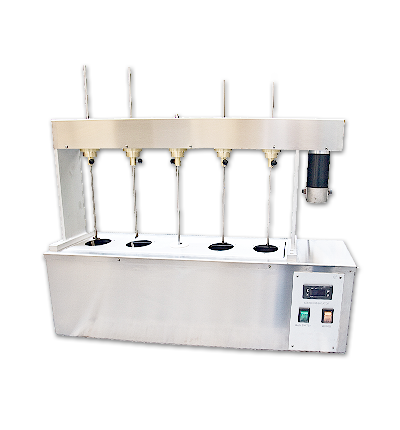NACE TM 0172
Standard Test Method for Determining Corrosive Properties of Cargoes in Petroleum Product Pipelines
This NACE TM 0172 standard test method is intended to determine the corrosive properties of petroleum product pipeline cargoes. This method provides guidelines for performing the test method described in ASTM D 665. The method has been modified however to be applicable to gasoline, fuels and other petroleum products, and so that it permits analysis within a single working day. This short corrosion test is particularly applicable to a control procedure of batches of products due to the need for prompt release of cargoes and decision making during the working day.
“Corrosion is a serious threat to the safety of oil and petroleum products transportation by pipelines and rail cargoes. Integrity of equipment of the Oil pipelines and rail equipment and installations. The World Corrosion Organization (WCO), estimates an annual cost in maintenance and shutdowns of 2.5 billion dollars worldwide”. Management is intensively involved with monitoring pipelines, equipment and installations by remote visual inspection, ultrasound, digital radiography, electromagnetic methods and the direct analysis of streams. Additives and surface coatings are used in a widespread of formulations to mitigate the problem.
Despite the big economic impact of the corrosiveness of products and materials, the methods are characterized by having a subjective operator’s visual rating with a considerable biased appreciation. The method revision and development strive to improve the precision and reduce bias as possible, so the automated digital detection imaging rating technique will be fully accepted.
Referenced Documents
ASTM Standards:
A108 Specification for Steel Bar, Carbon and Alloy, Cold-Finished
A240/A240M Specification for Chromium and Chromium-Nickel Stainless Steel Plate, Sheet, and Strip for Pressure Vessels
D91 Test Method for Precipitation Number of Lubricating Oils
D665 Standard Test Method for Rust Preventing Characteristics of inhibited Mineral Oil in the presence of water
D4057 Practice for Manual Sampling of Petroleum and Petroleum Products
E1 Specification for ASTM Liquid-in-Glass Thermometers
Other Standards:
NACE Standard TM 0172 Test Method for Determining Corrosive Properties of Cargoes in Petroleum Product Pipelines
Method Summary
Mix 300 mL of the oil with 30 mL of distilled water or synthetic sea water, at a temperature of 60 ± 1°C with a cylindrical steel test rod described in Fig.1, totally immersed in the vessel. The test is run for 4 h; however, this time might change depending on contract agreements. At the end of the test, the specimen is inspected for signs and degrees of rusting.
Significance and Use
This standard test method is intended to be used by corrosion engineers, corrosion technicians, corrosion consultants, scientists, and others concerned with determining the antirust properties of gasoline, distillate fuels and mineral oils for transport through petroleum product pipelines.
Test Specimen Preparation
Specimens are made according to the dimensions shown in the diagram below and should be prepared from steel according to reference ASTM A108. Rods from previous test can be used only if they are free from rust or other noticeable irregularities. If this is the case the preliminary grinding step can be omitted.
Specimens are mounted in the chuck of the grinding apparatus which rotates at a speed of 1700 – 1800 rpm. After the final polishing the specimen which cannot be touched by bare hands are cleaned with a lint-free cloth and store in isooctane until needed. Please verify that the specimen conforms to the dimensions given in the diagram below and consult the full version of NACE TM 0172 or ASTM D665 standards for more detail on the rods preparation and use.
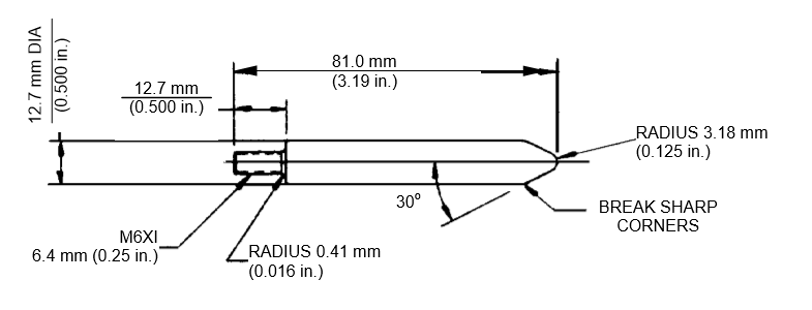
Figure 1. Steel rod for testing corrosiveness of crude oils and products
Procedure for Automated Digital Detection Imaging Rating
Test Method D665 is strictly adhered to as described in the Standard’s Last Revision.
The apparatus description, Automatic Rating Test Procedure, Calibration, Validation, and Interpretation of Results will follow.
Procedure
The injection of the sample is automated and occurs according to the Eralytic’s model and instructions. The injection of the sample in the dedicated density meters occurs either manually by means of a syringe or automatically by a built in pump according to the KEM Operation Manual and model. Automated or Manual Syringe Injection in all product lines takes precaution for sample integrity and bubbles absence as describied in D4052 Section 12. Follow manufacturer’s instructions for ensuring the integrity of the test specimen prior to analysis, as well as transferring a representative test specimen into the instrument for analysis.
Terminology
Definitions:
corrosion, n—chemical or electrochemical reaction between a material, usually a metal, and its environment that produces a deterioration of the material and its properties.
rust, n—corrosion product consisting primarily of hydrated iron oxide.
Discussion—Rust is a term properly applied only to ferrous alloys.
Acronyms:
FeDDI – Ferrum Digital Detection Imaging
Test Equipment and Apparatus
In general apparatus consists of a thermostatically controlled bath able to control the temperature in the test sample of 38 ± 1 °C (100 ± 2 °F). A modified (with baffles placed at 180° protruding 10 mm) beaker with a capacity of 400 mL Berzelius type glass beaker meeting the dimensions shown in fig.2 below. Baffles should be 102 mm long.
The beaker cover made of polymethyl methacrylate should have three holes to accommodate a 11.66 to 12.17 stirrer and a 6’1 to 6.6 mm in the center to accommodate the test rod assembly. The third hole with a diameter similar to the one for the stirrer should be centered of the cover at right angle to the other two holes.


Figure 2. Schematics and Testing Apparatus for NACE TM 0172 and ASTM D665
Automated NACE/Rust Apparatus ANA – TM0172
Alternately the testing rod can be placed in the NACE ANA apparatus ANA shown in Fig. 3. This is an automated single position test apparatus. ANA saves operator time for the sequences, controlling lock in position, time and temperatures. After the programmed time ANA will automatically rise the head to halt exposure and buzz to alert the operator to retrieve the specimen for either visual or automated rating.


Figure 3. Schematics of Automated Testing Apparatus ANA – NACE TM 0172 and ASTM D665
Testing Procedures
Test Method D665 is strictly adhered to as described in the Standard’s Last Revision.
Both, Beaker and cover should be thoroughly cleaned with isooctane or ASTM precipitation naphtha and dry oven. Wash thoroughly again with hot water and dry in an oven at a temperature < 65 °C.
300 mL of the sample should be placed in a bath maintained at 38 ± 1 °C (100 ± 2 °F), see figs 2 and 3 for schematics of testing equipment, Cover the beaker place both stirrer and temperature sensor at the specified distances and start the stirring to allow the sample to reach the test temperature. Insert the iron rod stir at 1000 ± 50 rpm for 30 minutes. At this point the sensor is removed to allow the addition of 30 mL of distilled water by pouring or injecting through the sensor hole. Stirring then continues for 3,5 hours at the set temperature. The specimen is removed, washed with xylene and toluene followed by acetone, dry and rate according to the scale provided in Table 1.
Digital Detection Imaging Apparatus
VISAYA Iron Digital Detection Imaging Device (FeDDI), improves the visual rating by determining the degree of corrosiveness digitally and integrally identifying exact levels of corrosion in a 4-step automated vision algorithm and classification process. FeDDI uses a high-resolution camera with CCD Digital Detection algorithm. The system provides highly repeatable results by rotating the specimen integrally 360° recording high resolution images and integrating the total area of exposure to automatically quantify, rate and display the degree of corrosion of the sample on test.
Digital Detection Imaging (FeDDI) Rating Apparatus — FeDDI is the first high-tech testing instrument powered by sophisticated optics, that facilitates and improves on the visual rating of methods ASTM D665 , D7548 and NACE TM0172.The digital detection imaging is achieved through a unique vision algorithm and light box that records, calculates and displays accurate corrosion ratings in a few seconds. This device shown in Figures 4a; 4b and 5 performs a standardized measurement of corrosion on the specimen while improves on visual ratings methods and sample handling procedures performed in current lab tests.
FeDDI’s patent pending NFX Handle — provides a standardized method for holding the test specimen at the ideal angle and direction for analyses. FeDDI’s loading and fastening mechanism eliminates the use of fragile and costly glassware for viewing. A unique feature of the NFX Handle illustrated in Fig. 6, is the integration of the stepper motor and electronics responsible for proper specimen rotation. By having the motor integrated into the NFX Handle, essentially all critical moving parts are placed in an easy to replace assembly for quick and easy serviceability. Proper handling of the sample is critical to an accurate rating both manually and by using the FeDDI technique.

Fig. 4 Digital Detection Imaging Device (a). Cross section view (b)

Fig. 5 FeDDI Rear view
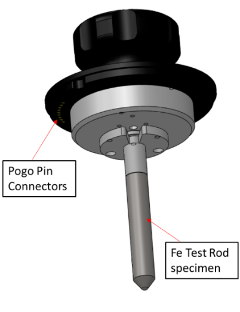
Fig. 6 NFX Handle
Calibration and Validation
An especial calibration procedure, can be used in the field, for periodic verifications. Light conditions, colors and algorithm, remain unchanged throughout the sequence testing thereby ensuring a proper QC procedure necessary for users and accredited laboratories.
The calibration standard procedure starts by activating and regulating the LED light. Voltages and currents control the light box for consistent Ambient Light Environment.
The quick and easy calibration procedure, ensures FeDDI is reporting at the optimum levels.
Interpretation of Results: Automated Procedure
To rate a testing rod specimen and report an oil as passing or failing, place the exposed test specimen in the FeDDI rating instrument following the Operator’s Manual instructions. FeDDI will automatically analyzed any test rods that have been exposed to any material of all testing procedures described in sections 9,10 and 11 of standard test method D665; section 10 of the accelerated iron corrosion method D7548 or section 4 of NACE TM-0172 method.
Stainless Steel Specimen Examination:
The corrosion digital rating is performed per the following automated steps:
Step 1: Insert the specimen into specialized NFX holder Fig. 6
Step 2: Place NFX holder into instrument
Step 3: LED light source is automatically activated and regulated
Step 4: Software identifies and calculates dimensional data
Step 5: Software rotates specimen at specific degree increments
Step 6: Readings are tabulated and processed through FeDDI algorithm
Step 7: Final Results are displayed on a high-resolution touch screen as shown in Fig. 7.
FeDDI will then run its analysis using the same method as fully automated mode, however, the display of data will be different. These differences include:
- Rating display box will show the Manual Rating along with the Automated Rating
- Final Rating Selection, which is done by selecting either Manual or Auto
- Override Rating can also be used in this mode.
Operator can select either the Manual or Auto rating as the final rating value.
All pre-loaded Test Methods comply with the ASTM D665, NACE TM0172 and ASTM D7548 experimental conditions for the different petroleum product classes defined in the scope of the specified standard methods.
Interpret the corrosiveness of the sample in accordance with the degrees of rusting described in section 12, Note 16 of the D665 standard test method, or the classifications of the accelerated ASTM D7548 Iron Corrosion Testing Chart described in Table 1 and Section 5, Rating of Test Specimen of NACE TM0172 Method.
Automated Rating: FeDDI uses a sophisticated algorithm for determining degrees of corrosion on standard iron test rods. The system will rotate the specimen integrally 360° recording high resolution images integrated to the total area exposed for automatic quantitation and classification. In the rare occasion that the user does not agree with the rating, the user can click on the “Override rating…” button to bring up a familiar looking chart, which can be used to manually select a rating as determined visually. FeDDI will then store this data together with the original automated rating.
Manual Rating: When a specimen is in the obvious transition state, the operator has the option to do a manual verification and visual inspection before the final classification is reached and displayed as shown in Fig. 7.
Repeat the test if blemishes due to fingerprints are observed, or due to spots from any particles or water droplets that may have touched the test specimen during the digestion period.
Repeat the test also if the area of the specimen appears to have anomalies due to discoloration or roughness that might require specimen reprocessing or polishing.
Rating Percent of Test Surface Corroded (%)
A 0
B++ Less than 0.1 (2 or 3 spots of no more than 1 mm (0.04 in.) diameter)
B+ Less than 5
B 5 to 25
C 25 to 50
D 50 to 75
E 75 to 100
Table 1. Rating of the Test Specimen.
Report
Automated Rating Procedure: Report the corrosiveness in accordance with one of the classifications listed in Table 1. State the duration of the test and the test temperature in the following format:
Corrosion Classification
The test report also shall contain the following:
The type and identification of the product used
The date of the test
A reference to this ASTM-IP standard, indicating whether Procedure A, B, or C was used. Since Procedure C may be followed with either distilled water or sea water, be sure to include the type of water used in this case,
The duration of the test
Method tested and special experimental conditions thereafter
Any deviation from the procedure specified and
The result of the test, including degree of severity of rusting, if desired.
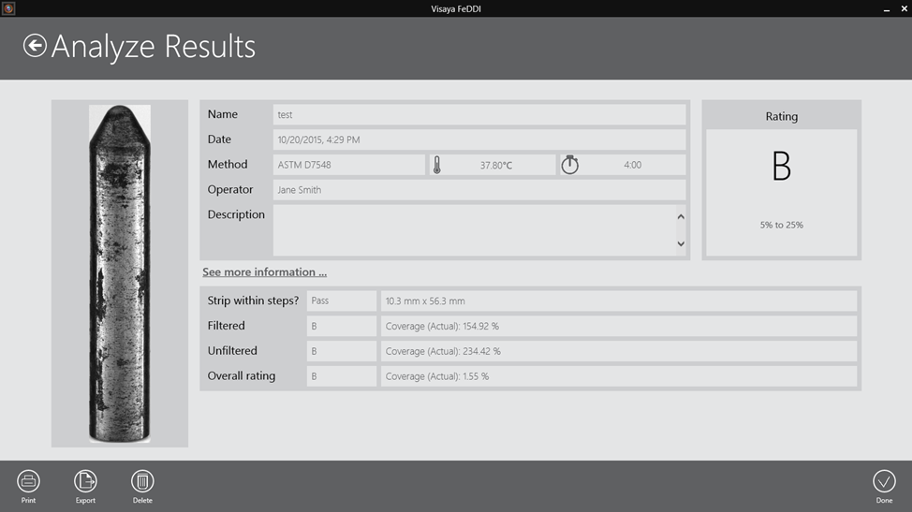
Fig. 7 Display of results and rating in Automatic mode
Precision and Bias
No generally accepted method for determining precision or bias is currently available.
FeDDI Internal Repeatability Study
A mini round robin on twelve samples with two measurements each show an excellent repeatability for the analysis. Table 2 displays the ratings assigned by FeDDI and important parameters like covered and total area as well as the corresponding tester dimensions. Values clearly indicate absolute compliance with ASTM repeatability definition.
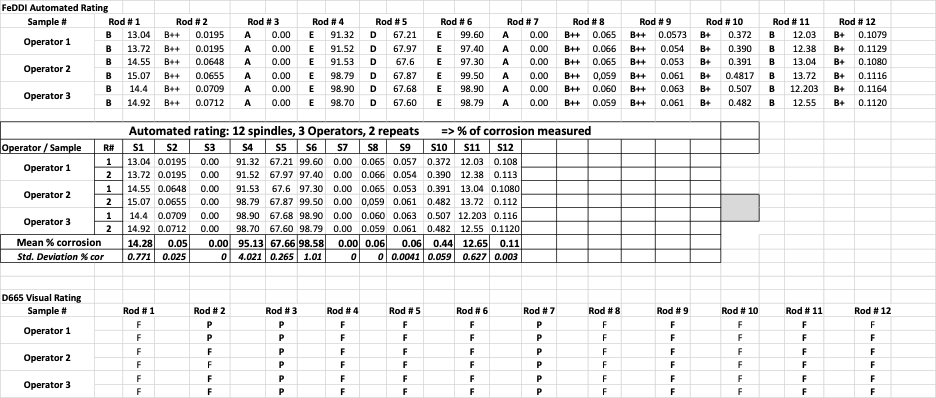
Table 2. FeDDI Experimental Results
Safety Precautions
Tests shall be conducted in large, and well-ventilated laboratories or in extraction hoods to avoid the concentration of flammable vapors. Personnel conducting the test should be aware of the hazards of handling volatile products such as gasoline. Please refer to ASTM D4057 standard and to the safety requirements of the laboratory.
Keywords: petroleum product cargoes, circulating oils; heavier-than-water fluids; hydraulic oils; inhibited mineral oil; rust-preventing characteristics; steam-turbine oils; FeDDI, Digital Detection Imaging; automated corrosion ratings.
